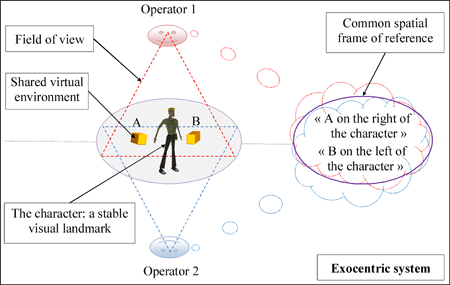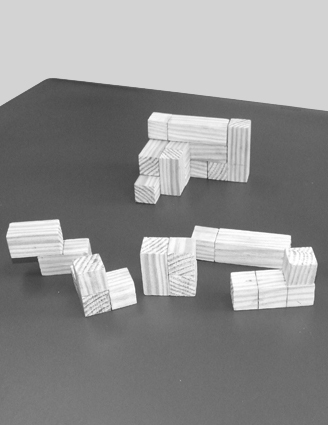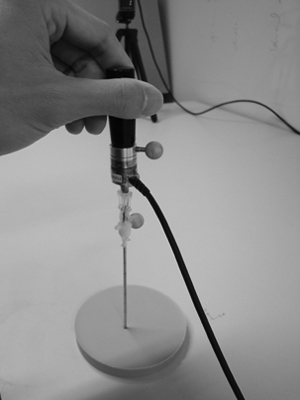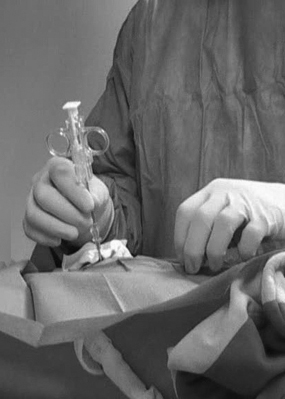Current research positions
Assistant professor in the IRA2 (Interaction, Réalité Augmentée, Robotique Ambiante) team at the IBISC Laboratory (Laboratoire d'Informatique, Biologie Intégrative et Systèmes Complexes), Evry, France.
Keywords
Human Computer Interaction, 3D Interaction, Virtual Reality, Collaborative Virtual Environments (CVE), Haptic Interaction, Haptic perception, Spatial Communication, Human Factors, Human Centered Design, Cognitive info-Communication, Motor skills learning, Robotic surgery, teleoperation and telesurgery.
Research objectives and topics
Research Objectives
My research objectives are to study the user within the environment with which he/she interacts and to design systems that better fits his/her needs in terms of training and collaborative work. My work is focused, more particularly, on spatial and haptic communication, the development of the common frame of reference in collaborative virtual environments, and the analysis and evaluation of human skills.
My research is based on two main axes:
Common Frame of Reference
To collaborate efficiently, two operators working together try to have consistent representations of their shared situation. This is called the Common Frame of Reference (COFOR) or the common ground. The COFOR is constructed and updated through the Grounding process that consists of a continuous exchange of information and signs of mutual comprehension between the partners. This helps the partners to understand each other and to organize their individual actions, taking into account their partner's actions.
My work in this area consists of studying different elements that can affect the COFOR development between two partners (e.g. the characteristics of communication in virtual environments). Once these elements identified and their impact on the COFOR development investigated, my objective is to provide recommendations for the design of user interfaces that support collaborative activities and the development of an efficient COFOR between users.
Collaborative learning of motor skills
The transfer of motor skills is a challenging issue in many applications such as surgery, design and industry. In fact, the process of transferring this knowledge is lacking of abstraction and formalism, i. e. motor skills are considered as inexpressible behavior: we can show the ability, but cannot explain the way to achieve it (e.g. driving a car). Furthermore, the information is transferred between the teacher and the learners through several channels, mainly, the visual, the verbal and the haptics-tactile channel. This global information is hard to capture faithfully. My research in this area investigates the use of VR technology to teach motor skills.
My work consists of investigating the contribution of each communication channel and a combination of the different communication channels in knowledge transfer. For that purpose, virtual environments are used to capture human haptic and visual-based behaviors. Conceptually, this is based on the projection of the sensory-motor space of the teacher on the learner's one. This implies naturally a loss of information: there is a reduction of the human sensory-motor space to the interface one. The learner has to recreate the initial information from the available one, i.e. the one coming from the interface. This is the first step toward the design of VR based systems that guaranty an optimal projection and back-projection of the human-sensory space. Having these last, one will be able to capture the knowledge and transfer it regardless to the physical presence of the teacher.
Beyond these two main research topics, I am interested in the following resulting issues:
Design of surgical training systems
My research in this topic consists of applying the design methods traditionally used in the fields of Human Computer Interaction and Human Factors to the design of medical systems and surgical simulators. For that purpose, methods like Tasks analyses, Task-centered design and Participatory design are used to evaluate the existing systems and to design new systems more adapted to the needs of the experts' surgeons and their fellows in terms of: skills efficiency and accuracy, patients safety, and training...(see related projects: P3, P4, P6, P7, P8, P9; related publications: J2, J3, J4, J6, J7, J8, J9, J10, C4, C5, C7, C8, C9, C10,C11, C14, C15, C16,Pos4, Pos5).
Haptic perception
My research in this topic consists of measuring the human's haptic sensitivity using a multi-sensor (force + position) system and silicon samples. This setup reproduces a needle insertion task in a patient's body. The objective of this research is to compare the haptic performances of experts (surgeons, radiologists, anesthesiologists...) to novice students. This comparison will permit to evaluate the human haptic sensitivity. Furthermore, it will allow in the future, to design and develop more effective haptic training systems for needle insertion tasks....(see related projects: P3, P4; related publications: C7, C8).
Haptic communication
My research in this area consists of studying the exchanges of information through the haptic channel. Haptic communication is investigated during collaborative manual tasks to understand the nature of information that can be exchanged through this channel. After that, haptic communication is investigated in several tasks to determine whether a haptic language exists and whether it can be easily understandable by human operators. By exploring patterns of haptic interactions, the objective is to improve the design of CVE and haptic devices used as collaboration tools between remote users. Applications areas are skills learning in surgery, social interactions, spatial interaction...(see related projects: P2, P3; related publications: J2,J3, C4, C5, C6, C12, P2, Pos3, T1).

Spatial communication and visual cues
Spatial communication is defined here as an exchange of information about objects positions in the space during co-manipulation tasks. My research in this area consists of studying the exchange of spatial information in virtual and remote environments. The objective is to determine which elements in the shared space can influence spatial communication. This is then used to define new spatial interaction metaphors in shared working spaces that help distant users to accomplish spatial tasks in collaboration (such as comanipulation tasks). Applications areas are Design, Architecture, Manufacturing, Laparoscopic surgery...(see related projects: P2, P5; related publications: J5,C1, C2, C3, C9, C13, N1, T2.

Co-presence in a virtual environment
Copresence is defined here as the sense of being with a partner in a shared environment. The sense of copresence can be disturbed when users work together in a collaborative virtual environment at a distance. My research in this topic consists of studying how social interactions are affected by the distance in virtual environments. The goal is then to increase the feeling of copresence between distant users of a shared virtual environment in order to improve their collaboration...(see related projects: P1, P2, P5; related publications: J2, J5, C1, C5, C13, T1).
Design of Collaborative Virtual Environments
The design of virtual environments that support collaborative work between distant users is still an open issue. My work in this area consists of using a human centered design approach to develop CVE. The idea is to take advantage of the cognitive psychology studies on human's collaboration and human's communication in order to improve users' interactions in the shared virtual spaces. The research objective is to provide recommendations for the design of CVE that help the users to work at a distance and to design new collaborative interaction techniques...(see related projects: P1, P2, P5, P7; related publications: J1, J2, J3, J5, C1, C2, C3, C4, C5, C13, N1, T1, Pos2.






